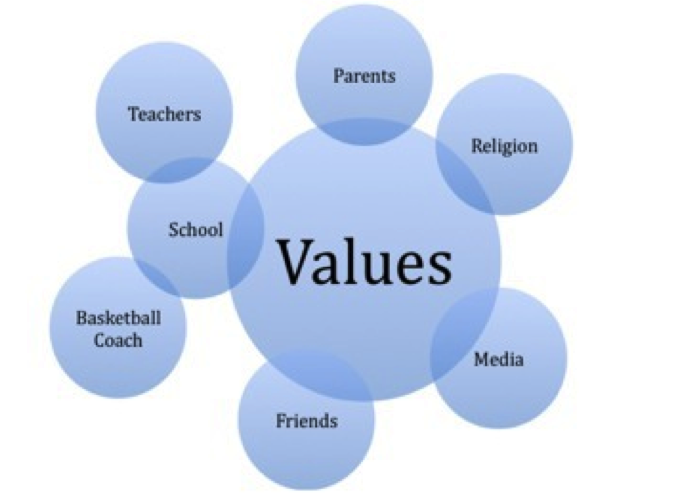JTE v25n2 - Cognitive Mapping Techniques: Implications for Research in Engineering and Technology Education
Cognitive Mapping Techniques: Implications for Research in Engineering and Technology Education
The primary goal of this paper is to present the theoretical basis and application of two types of cognitive maps, concept map and mind map, and explain how they can be used by educational researchers in engineering design research. Students thrive when they are afforded problem solving opportunities in ill-structured domains that embrace inquiry and design. As the frequency of these types of problem increases in high school curricula so are growing concerns that the problem solving strategies required to adequately approach and solve them may not be supported by the techniques and pedagogy used in most classrooms ( Crismond, 2011 ; Christian & Silk, 2011 ). One of the approaches to enhance problem solving in ill-structured domains is cognitive mapping. Cognitive mapping techniques can also be useful to researchers as they study students’ problem solving strategies and cognitive processes.
The increased emphasis on engineering design in technology education can present several pedagogical challenges because of the limited understanding of the cognitive strategies used by K-12 students when they are solving engineering design problems ( Lewis, 2005 ). Some even argue that current instructional approaches that are often used to teach subjects in ill-structured domains, such as engineering design and scientific inquiry, are not consistent with the cognitive architecture of novice learners ( Kirschner, Sweller, & Clark, 2006 ). This lack of alignment might explain why students encounter difficulty connecting previously learned concepts to the solving of ill-structured problems. The literature shows that in general novice learners do not organize their knowledge in a way that facilitates understanding, efficient retrieval, and application - resulting in ineptness in transferring previous knowledge to situations that differ from those studied in classroom ( Kirschner, Sweller, & Clark, 2006 ; Ellis, Rudnitsky & Silverstein, 2004 ). Nevertheless, research using cognitive mapping techniques can help educators understanding how students mentally represent design problems. They can also aid the teacher in the proper use of scaffolding techniques to guide students in the solution of complex designing problems.
Cognitive Mapping Explained
Cognitive mapping techniques have gained traction in business and education as tools to stimulate creative thinking and problem solving. Cognitive mapping techniques such as concept mapping and mind mapping can aid the teacher and the researcher by providing a “glimpse” into learners’ cognitive structure. Both the teacher and researcher can leverage this knowledge to improve their understanding of learning and problem solving.
Cognitive maps are regarded as "internally represented schemas or mental models for particular problem-solving domains that are learned and encoded as a result of an individual's interaction with their environment" ( Swan, 1997, p. 188 ). According to Semantic Theory, knowledge is stored in a network format where concepts are linked to each other ( Katz & Fudor, 1963 ). The more interconnected the knowledge, the higher the probability that a person will recall information when required. From a constructivist’s perspective, the learner attains new knowledge by integrating new information with existing knowledge structures. Therefore, the network mapping of concepts and their relationships externalizes how knowledge may be mentally integrated. These mental externalizations, or cognitive maps, are often termed concept maps, knowledge maps, and mind maps ( Turns, Atman, & Adams, 2000 ; Wheeldon & Faubert, 2009 ; Wycoff, 1991 ).
Concept Maps
Concept maps are graphical representations that illustrate how people visualize relationship between various concepts ( Plotnick, 1997 ). In its traditional form concept maps are graphical node-arc representations of concepts and their relationships with each other. The nodes of the map contain the concepts and the links between the nodes captures their interrelationships. Labeling the links provides information about the nature of the relationships ( Turns, Atman, & Adams, 2000 ). The links between the concepts can be one-way, two-way, or non-directional. The concepts and the links may be categorized, and the concept map may show temporal or causal relationships between concepts ( Plotnick, 1997 ).
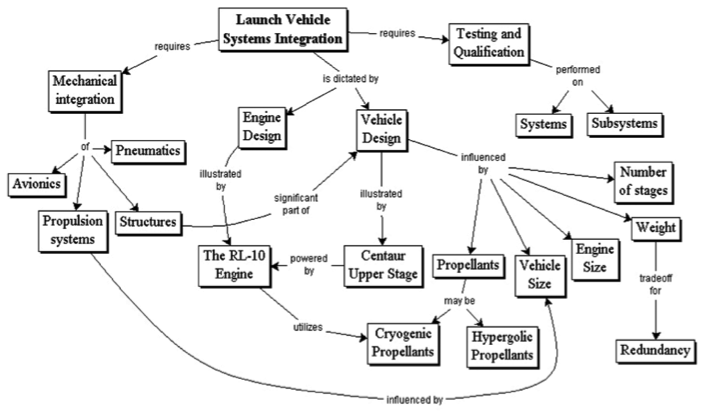
Concept maps have their roots in cognitive psychology and they attempt to illustrate a visual representation of the dynamic schemes of understanding within the human mind ( Wheeldon & faubert, 2009 ). Ruiz-Primo and Shavelson (1996) and Ausubel’s (1968) theories provide guidance as to what constitutes a concept map. They propose that concept maps should be hierarchical with superordinate concepts at the apex, labeled with appropriate linking words, and cross-linked so that relations between sub-branches of the hierarchy are identified. Novak and Gowin (1984) articulated that the hierarchical structure develops as new concepts are added, which are subsumed to more general inclusive concepts. The expansion of the hierarchy is govern by the principles of progressive differentiation, so that new concepts and links are added to the hierarchy either by creating new branches or by differentiating existing ones further. The external representations of cognitive structures, however, are not constrained by hierarchical concept mapping. Concept maps can also have a network, spider or chain structure.
The relationship between concepts can either be static or dynamic. A change in one concept can affect the state of the subsequent concept. A dynamic relationship between two concepts reflects and emphasizes the propagation of change in these concepts. It shows how a change in the quantity, quality, or state of one concept causes a change in the quantity, quality, or state of the other concept – signaling the functional interdependency of the two concepts involved. In engineering education, it is often necessary to illustrate the dynamic relationship between concepts. For example Ellis, Rudnitsky & Silverstein (2004) use dynamic concept maps to relate time varying forces to time varying motion, helping students to think beyond the equation of constant acceleration to generalized motion (see Figure 2).
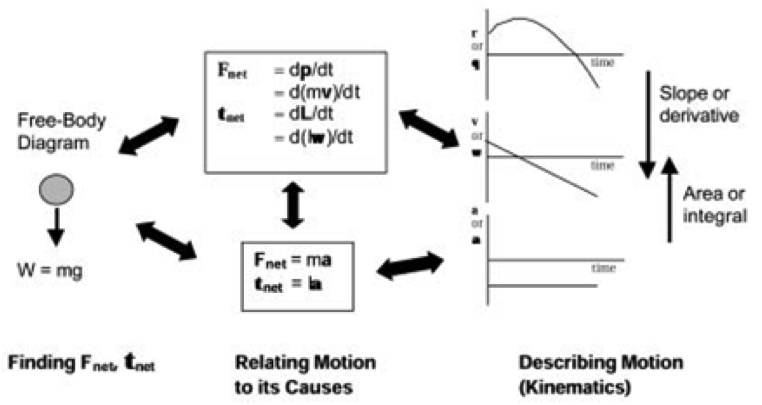
Mind Maps
Mind maps are primarily association maps. The aim of creating a mind map is to explore creative association between ideas. They are visual, non-linear representation of ideas and their relationship. Like concept maps they consist of a network of connected and related concepts. They differ from concept mapping in that the mind mapping process starts with a topic at the center of the graphic ( Buzan & Buzan, 2000 ). They are usually freeform, less formal and structured, and do not have labels that show the nature of the relationship between the ideas. Minds maps often use line thickness, colors, pictures and diagrams to aid knowledge recollection.
Mind maps have several pedagogical and cognitive benefits. The visual images created enhance student learning ( Budd, 2004 ). They also help students to make connections to material in meaningful ways. Nesbit and Adesope (2006) indicated that mind maps have been shown to lower extrinsic cognitive load because students are creating a two-dimensional space to tie in ideas and concepts that relate together. In addition, using mind maps also helps teachers vary their pedagogical methods in order to effectively reach diverse learners (Nesbit & Adesope, 2006). Mind maps have also been used as reflective tools that allowed for broader associations to be made to the material ( Budd, 2004 ). Buzan and Buzan (2000) recommended the following guideline when making a mind map:
- Place an image or topic in the center using at least three colors
- Use image, symbols and dimensions throughout your mind map
- Select key words using upper or lower case letters
- Each word image is alone and sits on its own line
- Connect the lines starting from the central image. Lines become thinner as they radiate from the center
- Make the lines the same length as the word image
- Use colors throughout the map
- Develop your own personal style of mind mapping
- Use emphasis and show associations in your mind map
- Use radial hierarchy, numerical order, or outlines to embrace your branches

While the overall goal of using concept and mind mapping techniques are similar, Davis (2011, p. 280) asserts that mind mapping “allows students to imagine and explore association between concepts while concept mapping allows students to understand the relationship between concepts and hence understand those concepts themselves and the domain in which they belong.” Concept mapping is the more flexible of the two and is researched and used more often in the classroom. Regardless of which type of mapping technique used, both can be useful techniques in aiding the researcher, teacher, and student learn and apply engineering and technology concepts and practices to solve problems.
Applying Cognitive Mapping in Research Methodologies
As engineering design becomes more prominent in technology education curricula, educational researchers should seek creative and constructive methods for studies in design cognition ( Petrina, 2010 ; Lewis, 2005 ). Cognitive mapping has been used successfully as a tool for analysis in both qualitative and quantitative research. An examination of these methods may illuminate technology education researchers on how this technique can be employed in research.
Quantitative Analysis
In a mixed method study that examined students’ conceptualization or mental representation of Information and Computer Technology (ICT), Pearson and Somekh (2003 , see also Somekh & Mavers, 2003 ) used concept maps to quantitatively assess students’ mental representations. Description of the maps generated by students more aligned with the definitions given for mind maps, however, the methods used can still inform engineering and technology educators researchers in their analysis.
The methods employed by Pearson and Somekh entailed the initial classification of maps into a predefined number of categories followed by the scoring of each map. The scoring was performed by counting the number of links and the number of nodes for each map. Furthermore, the representational richness of each map was scored by counting the occurrence of key objects. According to Pearson and Somekh (2003, p.12 ) , “the final quantitative analysis of the maps was undertaken by adding the items in all of the content categories together to produce a numeric score for each map which gave an approximation of its richness.” In another research study Turns, Atman, and Adams (2000) used concept maps to assess an introductory human factors engineering course at the course and program levels. The maps were scored on the comprehensiveness of the included concepts, the level of detail in the map – operationalized through the number of hierarchical levels – and the complexity of the links.
In general, the types of systems used to assign metrics to concept maps can be categorized into three general scoring strategies: scoring the components of the constructed map, comparing the constructed map with a criterion map, and using a combination of both strategies ( Ruiz-Primo & Shavelson, 1996 ). When scoring the constructed map the researcher can focus on the propositions (i.e., the amount, accuracy, and crosslinks), the hierarchy levels, and the examples. The examples are specific events or objects that are valid instances of those designated by the concept level. The scoring system may range from those that only use propositions to those that use a combination of all three. Using a criterion map allows a constructed map to be compared to a map constructed by an expert, and the overlaps between the two are scored. A content area expert can generate the criterion map or it can be an average of maps constructed by several experts. Novak and Gowin (1984) suggested a system to score concept maps (see Table 1).
| Component | Description | Score |
|---|---|---|
| Propositions | Is the meaning relation between two concepts indicated by connecting the link and linking word(s)? Is the relation valid? | 1 point for each meaningful, valid proposition shown. 5 points for each valid level of the hierarchy |
| Hierarchy | Does the map show hierarchy? Is each subordinate concept more specific and less general than the concept shown above it (in the context of the material being mapped) | 5 points for each valid level of the hierarchy |
| Crosslinks | Does the map show meaningful connections between one segment of the concept hierarchy and another segment | 10 points for each valid and significant crosslink.2 points for each crosslink that is valid but does not illustrate a synthesis between concepts and propositions |
| Examples | Specific events or objects that are valid instances of those designated by the concept level | 1 point for each example. |
Qualitative Analysis
It is likely that the use of cognitive mapping techniques finds more value in qualitative research. According to Miles and Huberman (1994) cognitive maps can be used in qualitative research for individual level analysis to display the complexity of a person’s thinking. As cognitive processes are not typically organized linearly, the flexibility in the structure of cognitive maps allows researchers to make observations about participants’ thought processes. As a technique, cognitive mapping can help researchers to understand the cognitive processes of students in engineering design and other types of technological problem solving. It offers engineering and technology researchers an additional approach for analyzing qualitative data obtained from interviews, focus groups, and observations. According to Hathaway and Atkinson (2003) , these creative means of engagement produce maps to probe the “backstage” of participants’ experiences and perceptions, and represent a new strategy that seeks to go beyond soliciting “a rehearsed form of narrative that precludes more spontaneous answers” (p. 162). Wheeldon and Faubert (2009) indicated that the front-end visual construction of a participant’s experience captured in a map can enable researchers to more specifically design subsequent stages of data collection and use participant-generated themes to help guide more in-depth analysis. These researchers asserted that cognitive mapping offer a means of gathering further unsolicited reflections providing a visual snapshot of the data in which to ground theory. This can aid researchers in refining subsequent data collection strategies.
Representing and communicating data and themes. The benefits of using cognitive maps are also rooted in the need for credible and trustworthy methods of analyzing voluminous text data. According to Daley (2004, p.1) ,
There is also the potential to utilize cognitive maps in more creative ways to analyze qualitative data. For example, Wheeldon and Faubert (2009) opined that limiting oneself to the traditional definition of mind or concept map could deny researchers of creative means to identify themes in qualitative research. These definitions constrain concepts maps to include clear and unique concepts, lines suggesting hierarchical relationships, and linking words. For example, the cognitive map depicted in Figure 4 lacks a clear hierarchy, linking words, and directional arrows, yet it offers a view of the individual’s understanding. It might not be appropriate to attempt to use this concept map alone to understand how an individual perceives the origin of his or her values, but the way in which the map is constructed might give way to more qualitative coding schemes or assist in the development of subsequent data collection approaches including interviews and focus groups ( Wheeldon & Faubert 2009 ).
Cognitive maps can help qualitative researchers in the methodological challenge to reduce data to a manageable form without losing the embedded meaning. Cognitive mapping techniques such as concept maps allows the researcher to: reduce the data in a meaningful way by providing visual identification of themes and patterns on a limited number of pages, identify overarching themes and their interconnected concepts, and present the findings of a qualitative research study as a graphical display so that readers can understand the findings and see how actual data quotes are connected to larger parts of the study.
As a technique to illustrate the complexity of students thinking in engineering design problem solving, cognitive maps can be used to depict how students categorized concepts in system design problems and capture patterns and themes in the cognitive strategy used by both novice, advance beginners, and expert problem solvers. Maps produced from these studies often reveal significant differences in the maps constructed by experts and those constructed by novices, differences that can inform curricula content and instructional strategies to improve students’ proficiency in problem solving ( Markham & Mintzes, 1994 ; Williams, 1998 ).
Categorizing concepts. Design problems are highly variable and complex, requiring a higher level of thinking. When solving system design problems students must meet desired needs within realistic economic, environmental, social, political, ethical, health and safety manufacturability, and sustainability ( ABET, 2011 ). In research, transcripts from students’ think aloud protocols can be analyzed using hierarchical concept maps to help researchers understand how students organize and categorize concepts, constraints, and strategies to reach acceptable solutions. Rich insight into students’ complex thinking processes can be gathered as their maps are compared with those of experts or more proficient problem solvers.
Patterns and themes. Both cognitive mapping techniques can be used by engineering and technology researchers to understand the pattern and identify the themes reflected in the cognitive process of expert problem solvers. For example, in one study that used think aloud protocols, Lammi and Thornton (2013) asked a novice and an expert engineer to design a new wireless network. Constraints were placed in the design challenge to create a realistic ill-defined scenario. The designers had limited capital, variable cellular traffic venues, and were up against strict zoning laws. A three dimensional aerial map overlaid with major and minor transportation thoroughfares was given to the engineers to aid in their design.
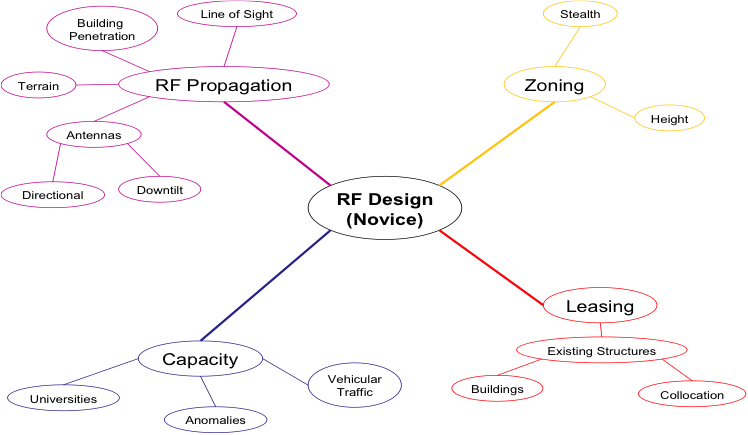
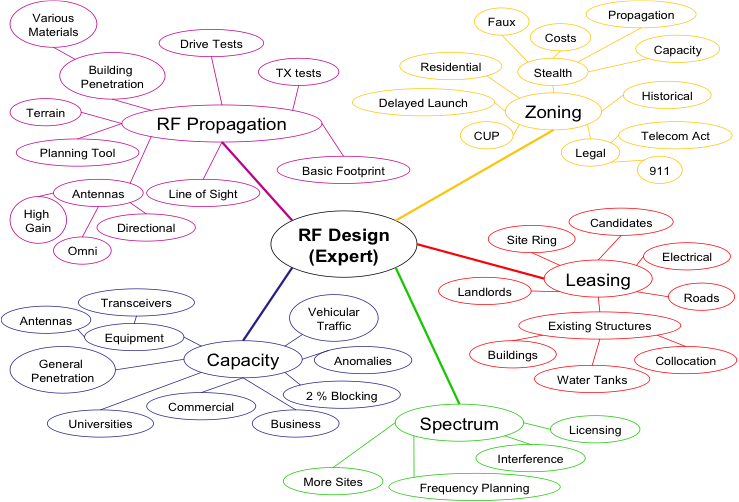
This study used verbal or “think aloud” protocol to gather the participants’ thoughts as they were performing their tasks. The audio data was broken into units or segments. The segments were then coded into distinct mental processes used in engineering design. The findings indicated certain patterns. For example the both novice and expert used a top-down approach to solve the problem and to evaluate and visualize their design against the various constraints. The cognitive maps captured disparities in the knowledge of the novice revealing that he displayed less breadth and depth of the problem knowledge and unlike the expert, failed to allude to or mention spectrum considerations (see Figure 5).
Revisiting the mixed method research mentioned previously, Pearson and Somekh (2003) asked children who were participants in the study to use concept maps to communicate their ideas about information and communications technology (ICT). A qualitative analysis of the maps drawn by each students indicated that ten year old children have well-developed representations of ICT, suggesting that they are in an ideal position to acquire a range of skills in the use of ICT provided they have access to tools and would be capable of using these tools to support their own learning.
Dixon (2010) used think aloud protocol to examine ten mechanical engineers' solving of a design problem. Six were students and four were professional mechanical engineers with many years of practice.
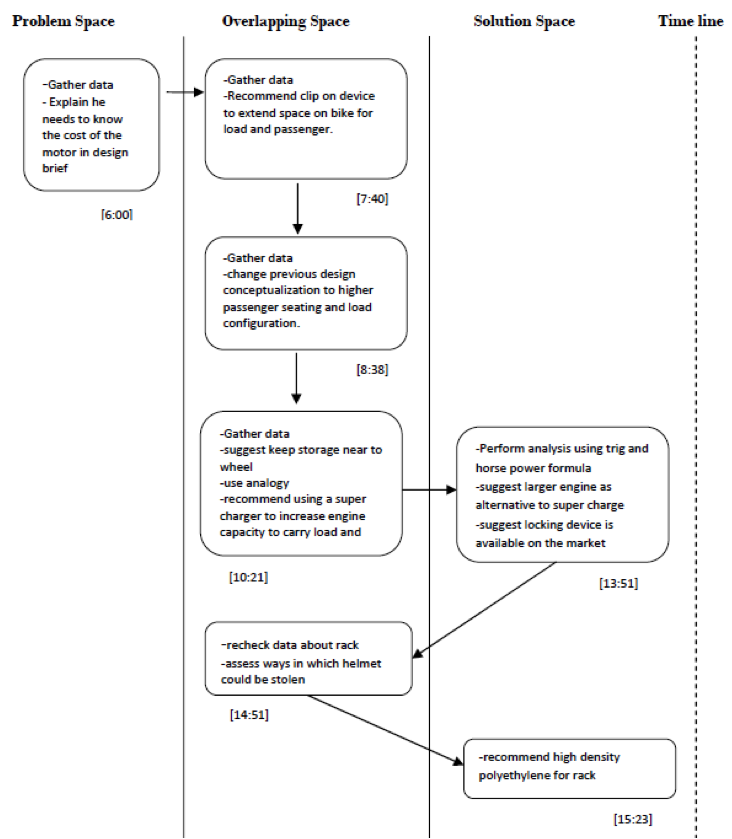
Their think aloud protocols were recorded, transcribed, and coded. One of the goals of the research was to determine how the expert and novice navigated the problem space, solution space, and the overlapping space (the space where information is interchanged between the problem and solutions spaces as they co-evolve). Cognitive maps were used at individual level analysis to explore how and at what stage of the design solution the novice and experts navigated the problem, solution, and overlapping spaces (see Figure 6). These cognitive maps supplemented other qualitative data analysis methods to established patterns in the novice and experts problem solving strategy. For example, the study showed that one pattern common between both groups was the iterative process that was reflected by going back and forth between the problem space and solution space. They both checked with the design brief or asked questions to verify or increase their understanding of the problem. This often led to the emergence of a different or modified conceptualization of the problem.
The maps also illustrate there were some difference in the pattern of exchange between the problem and solution spaces of the engineering student and professional engineer that took the shortest time to solve conceptual design problem. The patterns however, for the engineering student and professional engineer who took the longest time were more similar. Overall, the cognitive maps patterns showed that the engineering students spent less time than the professional engineers gathering and rechecking data regarding constraints, criteria, and other information that they considered relevant from the problem space.
Cognitive mapping allows the qualitative researcher to represent and communicate complex concepts and cognition, structure and adapt methodology, categorize salient concepts, and enhance thematic analysis. However, a disadvantage of concept maps in qualitative work is that analysis can become time consuming and the maps can be difficult to read by persons who are not acquainted with the format and as the maps becomes denser the linkages are harder to see ( Miles & Huberman, 1994 ). Despite these disadvantages, cognitive maps can be used in conjunction with other methods of data analysis to provide a more complete picture of the cognitive process and strategies, especially those in engineering design cognition.
Conclusion
As engineering design receive more attention in technology education curricula, the strategies used by technology educators to teach will improve as the number of research that examine the cognitive strategies used by students increases. Using cognitive mapping techniques to supplement other types of data analysis technique is one way technology education researchers can apply creative and constructive methods for studies in design cognition. Not only do cognitive mapping techniques help qualitative researchers in the methodological challenge to reduce data to a manageable form without losing the embedded meaning, if used creatively they can allow researchers to see unique themes or patterns used in design problem solving.
With the appropriate application of metrics, cognitive maps can also be used in quantitative data analysis. The examples highlighted in this paper illustrate how cognitive mapping techniques can be used effectively for quantitative data analysis. Its strength, however, exists in how it is able to aid the researcher to qualitatively analyze voluminous transcribed text data from expert and novices designers. While analyzing cognitive maps can be time consuming, properly constructed maps can illustrate how students categorize design concepts, display patterns in their cognitive strategy, and identify themes that emerge from the solving of design problems.
Raymond A. Dixon ( rdixon@uidaho.edu ) is Assistant Professor in Curriculum and Instruction at the University of Idaho. Matthew Lammi ( mdlammi@ncsu.edu ) is Assistant Professor in Technology, Engineering, and Design Education at North Carolina State University.
References
ABET. (2011). Criteria for accrediting engineering program . Retrieved from http://www.abet.org/uploadedFiles/Accreditation/Accreditation_Process/Accreditation_Documents/Current/eac-criteria-2012-2013.pdf .
Ausubel, D. P. (1968). Educational psychology: A cognitive view . New York, NY: Holt Reinhart and Winston.
Budd, J. W. (2004). Mind maps as classroom exercises. The Journal of Economic Education, 35 (1), 35-46. doi:10.3200/JECE.35.1.35-46.
Buzan, T., & Buzan, B. (2000). The mind map book . London, England: BBC Books.
Crismond, D. (2011).Scaffolding strategies for integrating engineering design and scientific inquiry in project-based learning environments. In M. Barak & M. Hacker (Eds.), Fostering Human Development through Engineering and Technology Education (pp. 235-255). Netherlands: Sense Publishers.
Christian, S. D., & Silk, E. M. (2011). Learning theories for engineering and technology education. In M. Barak & M. Hacker (Eds.), Fostering Human Development through Engineering and Technology Education (pp. 55-74). Netherlands: Sense Publishers.
Davis, M. (2011). Concept mapping, mind mapping and argument mapping: What are the differences and do they matter? Higher Education, 62 (3), 279-231.
Daley, B. J. (2004) .Using concept maps in qualitative research. In A. J. Cañas, J. D. Novak, F. M. González, (Eds.), Concept Maps Theory, Methodology, Technology . Proceeding. of the First Int. Conference on Concept Mapping, Pamplona, Spain.
Dixon, R. A. (2010). Experts and novices: Differences in their use of mental representation and metacognition in engineering design (Doctoral dissertation). Retrieved from https://www.ideals.illinois.edu/handle/2142/18376 .
Ellis, G. W., Rudnitsky, A., & Silverstein, B. (2004). Using concept maps to enhance understanding in engineering education. International Journal of Engineering Education, 20 (3), 1012-1021.
Hathaway, A. D., & Atkinson, M. (2003). Active interview tactics in research on public deviants: Exploring the two-cop personas. Field Methods, 15 , 161–185.
Katz, J. J., & Fodor, J. A. (1963). The structure of a semantic theory. Language, 39 (2), 170-210.
Kirschner, P. A., Sweller, J., & Clark, R. E. (2006). Why minimal guidance during instruction does not work: An analysis of the failure of constructivist, discovery, problem-based, experiential, and inquiry-based teaching. Educational Psychologist, 41 , 75–86.
Lammi, M., & Thornton, T. (2013). The cognitive processes and strategies of an expert and novice in the design of a wireless radio frequency network. Journal of Technology Studies. 39 (2), 92-100 .
Lewis, T. (2005). Coming to terms with engineering design as content. Journal of Technology Education, 16 (2), 37-54 .
Markham, K., & Mintzes, J. J. (1994). Concept maps as a research and evaluation tool: Further evidence of validity. Journal of Science Education, 31 (1), 91-101.
Miles, M. B. & Huberman, A. M. (1994). Qualitative data analysis: An expanded sourcebook (2nd ed.). Thousand Oaks, CA: Sage.
Novak, J. D., & Gowin, D. R. (1984). Learning how to learn . New York, NY: Cambridge Press.
Nesbit, J. C., & Adesope, O. O. (2006). Learning with concept and knowledge maps: A meta-analysis. Review of Educational Research, 76 (3), 413-448.
Pearson, M. & Somekh, B. (2003). Concept-mapping as a research tool: A study of primary children’s representations of information and communication technologies (ICT). Education and Information Technologies, 8 (1), 5–22.
Petrina, S. (2010). Cognitive science. In P. Reed & J. E. LaPorte (Eds.), Research in Technology Education (pp.135-151). New York, NY: Glencoe-McGraw Hill.
Plotnick, E. (1997). Concept mapping: A graphical system for understanding the relationship between concepts. Eric Clearinghouse . Retrieved from http://www.ericdigests.org/1998-1/concept.htm .
Ruiz-Primo, M. A. & Shavelson, R. J. (1996). Problems and issues in the use of concept maps in science assessment. Journal of Research in Science Teaching, 33 (6), 569-600.
Somekh, B. & Mavers, D. (2003). Mapping learning potential: Students’ conceptions of ICT in their world. Assessment in Education, 10 (3), 409-420.
Stewart, J., Van kirk, J., & Rowell, R. (1979). Concept maps: A tool for use in biology teaching. American Biology Teacher, 41 (3), 171-175.
Swan J. (1997). Using cognitive mapping in management research: Decisions about technical innovation. British Journal of Management 8 (2), 183-198.
Turns, J., Atman, C. J., & Adams, R. (2000). Concept maps for engineering education: A cognitively motivated tool supporting varied assessment functions. IEEE Transaction on Education, 43 (2), 164-173.
Williams, C. G. (1998). Using concept maps to assess conceptual knowledge of function. Journal for Research in Mathematics Education, 29 (4), 414-421.
Wheeldon, J., & Faubert, J. (2009). Framing experience: Concept maps, mind maps, and data collection in qualitative research. International Journal of Qualitative Methods, 8 (3), 68-83.
Wycoff, J. (1991). Mindmapping: Your personal guide to exploring creativity and problem-solving . New York, NY: Berkly Books.
